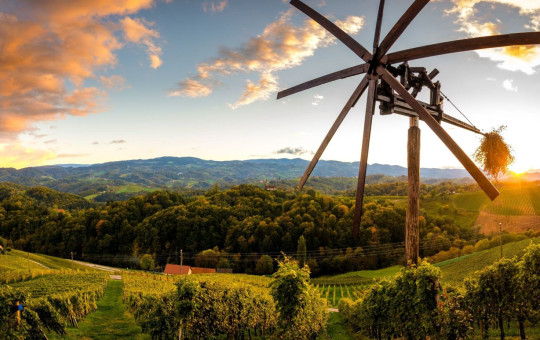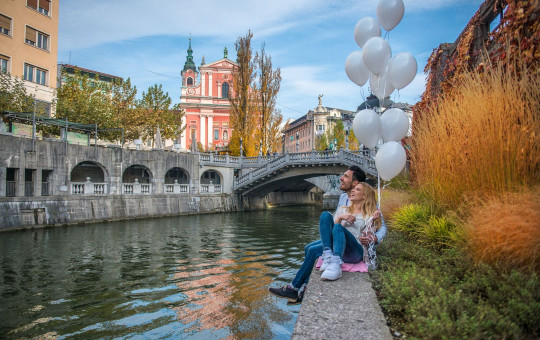Škocjanski zatok Nature Reserve is a Mediterranean wetland covering 122 hectares, and at the same time the largest brackish marshland in Slovenia. This is a wonderful place to go for a trip, a walk, or a jog, and it also has an interesting educational trail.
The formation of this nature reserve is associated with the urban development of Koper and its surroundings. In the past, Koper was an island where the sea cut into the land, forming three small bays: Semedelski Bay, Škocjanski Bay, and Polje Bay. Salt harvesting has been one of the dominant activities in this area since the Roman times. In the 19th century, salt pans covered the smaller part of the area, enclosing the island of Koper in a semicircle from the south side.
Salt pans were separated by the River Bradaševica, which lay its deposits there. The larger part was located on the north-eastern side of Koper, i.e. on both sides of the River Rižana.
When, at the beginning of the 20th century, the price of salt began to decrease, resulting in the gradual decline of salt harvesting, Koper and its surroundings changed too. The Port of Koper’s construction also had a major impact on the appearance of the area. The Škocjanski zatok has existed since 1957, when an 877 m-long dike between Koper and the outflow of the Rižana was built.
-

The halophyte perennial plant - swamp sea-lavender (Limonium angustifolium) blooms from July to September and has violet flowers. Photo: Miroslav Kastelic
-

The semi-saline (brackish) Škocjanski zatok with nesting islets, coastal wetlands and tidal marshes where various halophyte species grow comprises almost three quarters of the Škocjanski zatok. Photo: Miroslav Kastelic
Educational trail
The educational trail runs between the reeds and open water bodies, with nicely arranged posts featuring information boards about the animals and history of the place. The most widespread salt-tolerant plant species growing in the brackish Škocjan lagoon include the common glasswort (Salicornia europaea), swamp sea-lavender (Limonium angustifolium) and saltworts (Sarcocornia fruticosa).
A special feature of the Škocjanski zatok is its reedbeds.
-

The Škocjan lagoon is one of the most important nesting sites of the common little bittern (Ixobrychus minutus) in Slovenia, which due to its endangered species status in the past has become the symbol of the Škocjan lagoon. It is the smallest among European herons, and its breeding habitats are intertwined water ditches covered with dense reeds, common rush and low growing shrubs. Photo: Katjan Kravos
-

Common glasswort (Salicornia europaea) is an annual plant adapted to salty ground, and grows in the semi-saline Škocjan lagoon. In late summer and autumn it turns a beautiful reddish colour. Photo: Borut Mozetič
The Škocjanski zatok is especially important because of its rich biodiversity, with over 1,400 different plant and animal species having been recorded so far.
Birds are extremely important: in the last 15 years as many as 252 bird species have been documented in the area, which accounts for 60% of all the species that have been observed in Slovenia.
Among animal species, insects prevail (more than 360 species of butterflies, over 300 species of beetles, 41 species of dragonflies, etc.); moreover, 36% of the mammal species (25 species), 41% of the amphibian species (seven) and 41% of the reptile species (eight), present in Slovenia have been found here.
-

Common kingfisher (Alcedo atthis) is a species that is present in the Nature Reserve area throughout the year, but it does not nest in the Škocjan lagoon. Photo: Danilo Kotnik
-

Podolian cattle, the old Istrian breed, helps balance vegetation by grazing, delighting visitors and reminding them of the old times when harmony between humans and animals reigned in everyday life. Photo: Miroslav Kastelic
The Škocjanski zatok area is also important in the broader international context, as many bird species valuable in Europe and worldwide, as well as endangered species, stop over during their migration and wintering.
Projects for the regulation of the Škocjanski zatok
The latest project, which was launched last year, is the IMPRECO project, which is aimed at preserving ecosystem services by strengthening the biodiversity potential of protected areas, and preserving ecosystems through transnational cooperation. Before this, the projects of AdriaWet 2000, Natura Primorska, Restoration of Škocjanski Zatok, Facilities in Škocjanski zatok Nature Reserve and Škocjanski zatok – an outdoor classroom for everyone, had been successfully implemented. All these projects were financed from the EU budget, and are the result of successful cooperation between different countries.
Protection of nature
The Škocjanski zatok Nature Reserve was protected by the Škocjanski zatok Nature Reserve Act in 1998, and while this is no longer in force its protection was continued by the adoption of the Škocjanski zatok Nature Reserve Decree in 2013.
Besides its protected status, the Škocjanski zatok is also an Ecologically Important Area (EPO), and part of Natura 2000, a European network of Special Protection Areas declared by the member states of the European Union.
The Škocjanski zatok is like an emerald, precious and brilliant in its green colour. Let us keep it like that for our successors to enjoy.
Date: 27. May 2020
Time to read: 3 min









